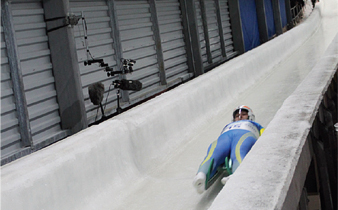Olympics: Cutting Ice in 5.1
VANCOUVER
Blades cutting ice. A skier holding his edge in powder. A spectator's cowbell mingling with the rumbling swoosh of a bobsled tearing across the TV screen from left to right.
The sounds of winter sporting events are quite distinct from the more common sounds of summer sports, and the audio accompanying NBC's pretty pictures of the Vancouver Games was of a caliber not reached before, according to Bob Dixon, NBC Olympics Director of Sound Design in Vancouver.
"To me it's the best sound we've had in the 12 Olympics I've done," he said.

OBS placed mics all along the luge track to capture the sound of the blades screaming down the ice track. Dixon said the quality of the mixes was "very nice" overall in terms of the balance, the clarity of what was going on, the pick-up of the sound effects, and the richness of the surround channels.
He added that the sound was more in tune with the picture than ever before, citing the bobsled and luge sliding events as prime examples.
"These happen very fast, and they [the athletes] get tossed around when they roar past you," said Dixon. "The audio has been right there with it by using a lot of mics along the runs [so] the sound does the same thing as the cameras pan, now more than ever before."
Dixon was quick to commend host broadcaster OBS as a central pillar of the audio that came from Vancouver, citing as two examples those microphones placed all along the sliding track to capture the fast moving sleds, as well as the surround mic placements in the start houses at the top of the mountain.
The latter was a location Dixon had wanted to get in surround, even considering a unilateral mic placement of one of the single-mic 5.1 solutions now available, to supplement the host coverage. But in the end, OBS' Sound Designer Dennis Baxter opted for full surround capture in the start houses, so additional coverage was not needed.
Dixon had been working with Baxter all along, and a fair amount of host audio was used. He looks at the host plots and adds mics when desired and positions are available.
"For example, they [OBS] do a nice mix on hockey, but if they're in a wide shot and our director punches up a camera down at the low corner, and he's got the screen full of a guy getting smashed against the glass, the host may be in wideshot [with more general hockey sound]."
To manage this possible issue, Dixon supplemented the host mics with additional [Audio-Technica 4050] mics at the goal line, blueline, redline, and at center ice. "All of these are available to the mixer, along with mics hanging over the ice, so we can get our own ambience," he said.
The goal is flexibility—in the hockey example, NBC also ordered the host ambience in 5.1 to supplement its own content, host sound effects in 5.1 without any crowd, and the host crowd separately. "[With these] the mixers can do balance between atmosphere and field of play and make it what we like, and we can get in close when we need to with mic splits," he said.
AUDIO INFRASTRUCTURE
NBC's Vancouver facilities used a similar audio infrastructure as used at the Beijing Games—14 channels of embedded audio that left the venue and was carried around the plant. Channels 9-14 were sent back to New York as the network's discrete surround audio, and two channels of stereo program mix were sent as backup and for other uses.
How the 5.1 was produced in Vancouver varied with the venue. For live broadcasts, mixers created a true discrete 5.1 mix at the venue.
Competitions that were recorded for later playback, or went through an edit room, were more complex. These used feeds based on a two-channel mix passed through two separate Linear Acoustic AERO.qc upmix engines to return the signals to 5.1 for air.
In these situations the venue-based trucks sent a stereo mix of the full program, and a stereo mix of just the sound effects to the IBC, and tape accessed those parts of the signals, recorded channels 1-4, before upmixing via the AERO.qc to 5.1.
Since there's no announcer mix, the result was a "rich full signal," said Dixon. "We add the announcers, we extract them from the full program, and we take out the center channel from that upmix process which is where the announcers are, and we lay them on top of the upmix sound effects."
Dixon said the end result was not quite as good as when it was discrete, but it's a lot better than what they've done in the past: "It's much freer of artifacts than other things we might have used," (see "Pure World Audio").
5.1 requires a lot of thought and energy to satisfy what remains a fairly small number of viewers. Dixon and his staff kept in mind that the vast majority of home viewers were listening in stereo, resulting from a mix down at the consumer-level set-top or TV.
This results in the announcers having a lot of audio mixed in with them, so burying the announce team was a possibility. NBC kept an eye on this by consistently listening to a stereo mix down that replicates a set-top, also created by one of the 24 AERO.qc units NBC had spread across its Vancouver facilities.
STAFF EXPERIENCE, PREP
Dixon said since this was the second fully 5.1 Games, his staff in Vancouver had more experience, and it showed.
"I like to think that we do a lot of planning and offering them some guidelines to stick with," said Dixon. "We communicate a lot with the mixers before we arrive… they know about the channel layouts, they know about the mixing, they know we don't want to heavily compress anything."
Dixon said another big benefit to the overall production was having Calrec Omega consoles at the venues where NBC had facilities. He said that because the Calrecs are so popular within the OB market, most of NBC's mixers were very comfortable with the layout of the units, and this familiarity meant a lot when a mixer was being asked to do a very complex job in a hurry.
"This way the mixers can concentrate on how it sounds, not the mechanics," said Dixon.
ITU LOUDNESS STANDARD
Loudness was an issue in Beijing, where NBC set a dialnorm mixing target of –23 dB. In the 17 months since then, the ITU standard BS.1770 has become more widely deployed, and in Vancouver, NBC settled on a –24 mixing target, the recommended practice from that standard.
In Vancouver this was monitored with the busy Linear Acoustic AERO.qcs in the IBC and at every venue where NBC had facilities. The units show a numerical dB level, along with a graphical representation of loudness and a color-based display, where blue was too soft, green and yellow were the comfort zone, and red was too loud.
"What leaves here is –24, that is what New York receives from us," said Dixon. "We have a great sound mixer in New York taking in our program at the other end and inserting commercials at –24, so nobody's jumping for the remote control."
Dixon said that although loudness had been vastly improved over the last two Games, the final local leg of a broadcast chain—the local station—remains as a possible source of problems beyond the network's control.
Linear Acoustic President Tim Carroll spent much of his Olympics in the NBC "listening room" in the IBC, just as he did in Beijing. He said these Games were again a tremendous learning experience, and a great chance to get feedback directly from the operators on his products, in this case the AERO.qc boxes spread throughout the main facility and the venues. He said he was personally watching the WNBC feed coming back from New York "like a hawk" for loudness.
"In Beijing we had one or two commercials that stuck out, but it has not happened a single time here," he said.
Get the TV Tech Newsletter
The professional video industry's #1 source for news, trends and product and tech information. Sign up below.

